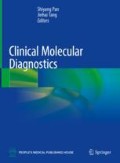Abstract
The birth and development of molecular biology is an important event and has become a leading discipline in the natural science. It drives the research of life science to a new stage and has produced vast knowledge in clinical sciences. Molecular diagnosis is based on the theory of molecular biology, and the studies include the changes of the existence, structure, or expression regulation of endogenous or exogenous biological macromolecules and macromolecular systems in human body using the techniques and methods of molecular biology, so as to provide information and decision-making basis for the prevention, prediction, diagnosis, treatment, and outcome of diseases. The development of molecular biology can be roughly divided into three stages: In the 1950s, it was determined that protein is the main basic material of life, and DNA is the material basis of biological inheritance, which laid a theoretical foundation for the development of molecular biology. In the early 1970s, Watson and Crick proposed that DNA double helix structure and base complementary pairing are the basic ways of nucleic acid replication and genetic information transmission, laying the most important foundation for understanding the relationship between nucleic acid and protein and its role in life. After the 1970s, with the emergence of PCR technology, the launch of the human genome project, and the rapid development of high throughput sequencing technology and mass spectrometry technology, humans began to deeply understand the nature of life and make great strides in the field of molecular diagnosis. This chapter will introduce the main methods of molecular diagnosis, including nucleic acid detection and protein detection. It can be assured that molecular has a bright future, but the road will be difficult and tortuous.
Access this chapter
Tax calculation will be finalised at checkout
Purchases are for personal use only
References
Tatipally S, Srikantam A, Kasetty S. Polymerase chain reaction (PCR) as a potential point of care laboratory test for leprosy diagnosis: a systematic review. Trop Med Infect Dis. 2018;3:107.
Zhang X, Zhang Y, Liu X, et al. Nested quantitative PCR approach for urinary cell-free EZH2 mRNA and its potential clinical application in bladder cancer. Int J Cancer. 2016;139:1830–8.
Bachman J. Reverse-transcription PCR (RT-PCR). Methods Enzymol. 2013;530:67–74.
Jozefczuk J, Adjaye J. Quantitative real-time PCR-based analysis of gene expression. Methods Enzymol. 2011;500:99–109.
Cao L, Cui X, Hu J, et al. Advances in digital polymerase chain reaction (dPCR) and its emerging biomedical applications. Biosens Bioelectron. 2017;90:459–74.
Morganti S, Tarantino P, Ferraro E, et al. Complexity of genome sequencing and reporting: next generation sequencing (NGS) technologies and implementation of precision medicine in real life. Crit Rev Oncol Hematol. 2019;133:171–82.
Whitfeld PR. A method for the determination of nucleotide sequence in polyribonucleotides. Biochem J. 1954;58(3):390–6.
van Dijk EL, Auger H, Jaszczyszyn Y, et al. Ten years of next-generation sequencing technology. Trends Genet. 2014;30:418–26.
van Dijk EL, Jaszczyszyn Y, Naquin D, et al. The third revolution in sequencing technology. Trends Genet. 2018;34:666–81.
Nielsen BS, Holmstrom K. Combined microRNA in situ hybridization and immunohistochemical detection of protein markers. Methods Mol Biol. 2019;1953:271–86.
Pongor L, Kormos M, Hatzis C, et al. A genome-wide approach to link genotype to clinical outcome by utilizing next generation sequencing and gene chip data of 6,697 breast cancer patients. Genome Med. 2015;7:104.
Bhalla N, Jolly P, Formisano N, et al. Introduction to biosensors. Essays Biochem. 2016;60:1–8.
Tonannavar J, Deshpande G, Yenagi J, et al. Identification of mineral compositions in some renal calculi by FT Raman and IR spectral analysis. Spectrochim Acta A Mol Biomol Spectrosc. 2016;154:20–6.
Feng Y, Wang B, Chu X, et al. The development of protein chips for high throughput screening (HTS) of chemically labeling small molecular drugs. Mini Rev Med Chem. 2016;16:846–50.
Zhao L, Wang D, Shi G, et al. Dual-labeled chemiluminescence enzyme immunoassay for simultaneous measurement of total prostate specific antigen (TPSA) and free prostate specific antigen (FPSA). Luminescence. 2017;32:1547–53.
Sastre J, Sastre-Ibanez M. Molecular diagnosis and immunotherapy. Curr Opin Allergy Clin Immunol. 2016;16:565–70.
Aggarwal SK. A review on the mass spectrometric studies of americium: present status and future perspective. Mass Spectrom Rev. 2018;37:43–56.
Author information
Authors and Affiliations
Corresponding author
Editor information
Editors and Affiliations
Rights and permissions
Copyright information
© 2021 People's Medical Publishing House Co. Ltd.
About this chapter
Cite this chapter
Du, L., Wang, C. (2021). Molecules of Disease and Their Detection Methods. In: Pan, S., Tang, J. (eds) Clinical Molecular Diagnostics. Springer, Singapore. https://doi.org/10.1007/978-981-16-1037-0_1
Download citation
DOI: https://doi.org/10.1007/978-981-16-1037-0_1
Published:
Publisher Name: Springer, Singapore
Print ISBN: 978-981-16-1036-3
Online ISBN: 978-981-16-1037-0
eBook Packages: MedicineMedicine (R0)

